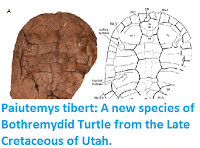Scientists in El Salvador are investigating after 300-400 dead Green Sea Turtles, Chelonia mydas, were found floating off the shore of the Jiquilisco Bay last week. Three Black Turtles, Chelonia agassizii, and three Olive Ridley Turtles, Lepidochelys olivacea, were also found. The cause of the deaths has not yet been determined, but previous mass Turtle deaths in the area have been found to have been caused by blooms of toxic Red Algae. Such Algae can poison a wide range of animals, including predatory animals such as Turtles, which can either consume the toxic algae along with desired prey, or be poisoned
by consuming prey that had itself ingested the harmful algae. Satellite images of the area show a rise in chlorophyll levels before the Turtles were found, which indicates the presence of an Algal bloom, but not whether it was comprised of harmful Algae. More will be known once tissues from the Turtles are subjected for analysis by toxicologists.
A dead Green Sea Turtle, Chelonia mydas, recovered off the coast of El Salvador last week. Reuters.
Green Sea Turtles are currently classed as Endangered under the terms of the the International Union for the Conservation of Nature's Red List of Threatened Species, due to a dramatic fall in numbers in the Pacific, Indian and Atlantic Oceans, due to exploitation of eggs, juveniles and adults both at nesting sites and in foraging grounds at sea, as well as degradation of breeding sites due to Human activity.
A variety of single-celled Algae can produce blooms, sudden population explosions that discolour the water, and can be toxic and cause problems by absorbing oxygen from the water, causing other aquatic organisms to asphyxiate. Red Algal Blooms (or Red Tides) are particularly notorious as many single-celled red Algae produce potent toxins. Such blooms are typically associated with warm weather, local drops in salinity, which can be caused by high rainfall levels or runoff from land, or rises in nutrient levels, which can again are often associated with runoff from land, but can be caused by large storms or other event stirring up nutrients from the ocean floor.
See also...
Follow Sciency Thoughts on
Facebook.







